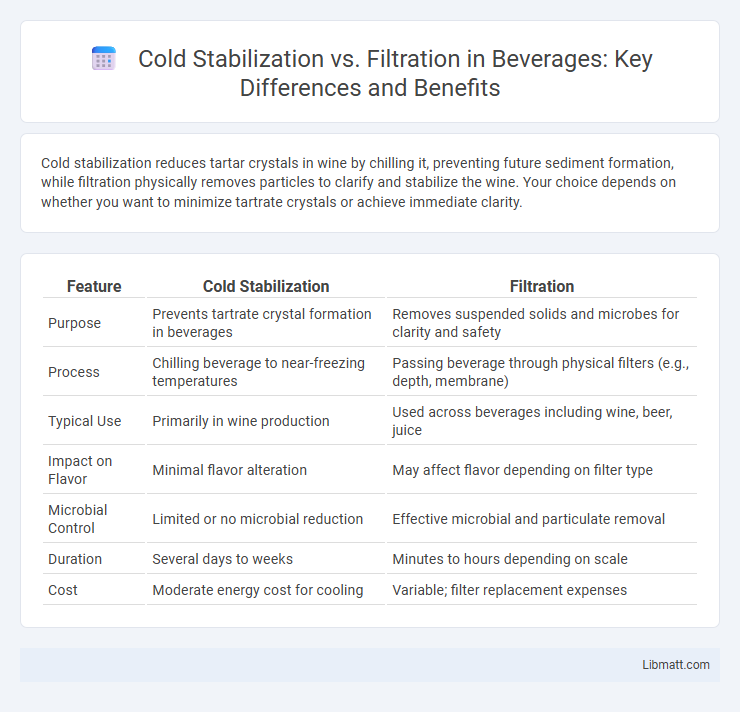Cold stabilization reduces tartar crystals in wine by chilling it, preventing future sediment formation, while filtration physically removes particles to clarify and stabilize the wine. Your choice depends on whether you want to minimize tartrate crystals or achieve immediate clarity.
Table of Comparison
| Feature | Cold Stabilization | Filtration |
|---|---|---|
| Purpose | Prevents tartrate crystal formation in beverages | Removes suspended solids and microbes for clarity and safety |
| Process | Chilling beverage to near-freezing temperatures | Passing beverage through physical filters (e.g., depth, membrane) |
| Typical Use | Primarily in wine production | Used across beverages including wine, beer, juice |
| Impact on Flavor | Minimal flavor alteration | May affect flavor depending on filter type |
| Microbial Control | Limited or no microbial reduction | Effective microbial and particulate removal |
| Duration | Several days to weeks | Minutes to hours depending on scale |
| Cost | Moderate energy cost for cooling | Variable; filter replacement expenses |
Introduction to Wine Clarification Techniques
Cold stabilization and filtration are essential wine clarification techniques that enhance clarity and stability by removing unwanted particles and compounds. Cold stabilization specifically targets tartrate crystals through chilling, preventing precipitation, while filtration physically removes suspended solids and microbes to ensure a clean, polished appearance. Understanding these processes helps you achieve a visually appealing wine with improved shelf life and quality.
Understanding Cold Stabilization
Cold stabilization is a winemaking technique used to prevent tartrate crystal formation by chilling wine to near-freezing temperatures, causing potassium bitartrate to precipitate out. This method enhances wine clarity and stability, reducing the risk of visual defects in bottled wine. Filtration, by contrast, primarily removes suspended solids and microbial contaminants but does not address tartrate stability as effectively as cold stabilization.
Overview of Filtration Methods
Filtration methods in wine production include depth filtration, membrane filtration, and crossflow filtration, each designed to remove particulates and microbial contaminants to ensure clarity and stability. Depth filtration uses porous materials to capture suspended solids, while membrane filtration employs micro- or ultrafiltration membranes to physically exclude yeast and bacteria. Crossflow filtration forces wine tangentially across the membrane surface, reducing clogging and enabling efficient removal of haze-causing proteins and microbes without impacting wine flavor.
Key Differences Between Cold Stabilization and Filtration
Cold stabilization removes excess tartaric acid crystals from wine by chilling it, preventing haze formation during storage, while filtration physically removes suspended particles and microbes to clarify and stabilize the wine. Cold stabilization primarily targets tartrate crystals without affecting flavor, whereas filtration can influence wine's texture and potentially strip some aroma compounds. Your choice depends on whether you aim to prevent crystal sediment or ensure microbial stability and clarity.
Impact on Wine Quality and Flavor
Cold stabilization enhances wine clarity and stability by reducing tartaric acid crystals without significantly altering flavor profiles, preserving the wine's original taste. Filtration improves wine purity by removing suspended particles and microbes, which can slightly affect aroma and mouthfeel, potentially leading to a cleaner but sometimes less complex flavor. Your choice between cold stabilization and filtration will depend on the desired balance between visual appeal and maintaining the nuanced character of the wine.
Equipment and Process Requirements
Cold stabilization requires refrigeration units capable of maintaining temperatures around 0-4degC for extended periods, often several days to weeks, to precipitate tartrate crystals effectively. Filtration demands equipment such as membrane filters or diatomaceous earth filters to physically remove suspended particles and microbes, ensuring clarity and stability. Both processes involve specific machinery tailored to their purpose, with cold stabilization focusing on thermal control systems and filtration relying on pressure and particle-retention technologies.
Pros and Cons of Cold Stabilization
Cold stabilization effectively prevents tartar crystal formation in wine, improving clarity and stability during storage. However, it can be energy-intensive and time-consuming, potentially impacting production efficiency and increasing costs. You should weigh these benefits against the more immediate results of filtration, which removes particulates but may affect flavor and mouthfeel.
Advantages and Disadvantages of Filtration
Filtration offers the advantage of effectively removing suspended solids, yeast, and bacteria, resulting in a clear and stable wine without altering its flavor profile. However, filtration can strip desirable phenolic compounds and aromas, potentially diminishing the wine's complexity and mouthfeel. It also requires proper equipment and expertise, increasing production costs and the risk of over-filtration, which may negatively impact wine quality.
Choosing the Right Method for Your Wine
Cold stabilization targets tartrate crystal removal by chilling wine to near-freezing temperatures, preventing future crystal formation and preserving clarity. Filtration physically removes suspended solids and microbial contaminants, enhancing clarity and stability without altering temperature-sensitive compounds. Selecting between cold stabilization and filtration depends on the wine style, stability goals, and desired sensory profile, with cold stabilization favored for preventing tartrate precipitation and filtration preferred for microbial control and immediate clarity.
Final Thoughts: Cold Stabilization vs Filtration
Cold stabilization effectively reduces tartaric acid crystals, enhancing wine clarity and stability, while filtration removes suspended particles to improve visual appeal and microbial safety. Your choice depends on the desired wine profile; cold stabilization preserves natural flavors and mouthfeel, whereas filtration provides immediate clarity but might strip some complexity. Balancing these techniques ensures optimal wine quality, tailored to your production goals and consumer preferences.
Cold stabilization vs filtration Infographic

 libmatt.com
libmatt.com